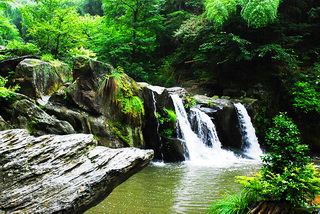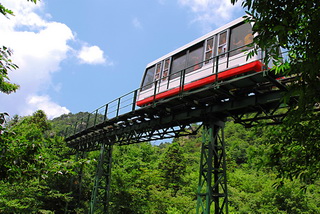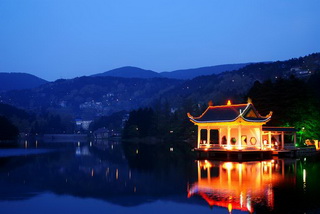 Lushan National Park is of great natural, scientific and historical value for China. The Chinese avant-garde of pastoral poetry, Tao Yuanming, was from Lushan and wrote Notes on the Peach Flower Land at the site. Other important figures who worked at Mount Lushan include Hui Yuan, who influenced the Chinese sect of Buddhism, Zong Bing, who created the initial theories of traditional nature paintings, Lu Xiujing, who composed the first Taoist Chronicle, and Wang Xizhi, who is the most esteemed Chinese calligrapher of all time.
Lushan National Park is of great natural, scientific and historical value for China. The Chinese avant-garde of pastoral poetry, Tao Yuanming, was from Lushan and wrote Notes on the Peach Flower Land at the site. Other important figures who worked at Mount Lushan include Hui Yuan, who influenced the Chinese sect of Buddhism, Zong Bing, who created the initial theories of traditional nature paintings, Lu Xiujing, who composed the first Taoist Chronicle, and Wang Xizhi, who is the most esteemed Chinese calligrapher of all time. The East Grove Temple was constructed by Hui Yuan and exhibits Buddhist China at the time of the Jin Dynasty. The famous philosopher Zhu Xi began his lecturing methodology during the Song Dynasty at the White Deer Cave and its corresponding Academy. His Lixue system was greatly influential in Chinese feudal society for over 7 centuries. It is also the location where Europeans and North Americans constructed vacation villas beginning in 1895. The aesthetic quality of Mount Lushan has been the muse of numerous writers, scientists and artist in China. It possesses mountains, valleys, waterfalls, rocks, and ponds as wells as Lake Poyang and the Yangtze River.
The East Grove Temple was constructed by Hui Yuan and exhibits Buddhist China at the time of the Jin Dynasty. The famous philosopher Zhu Xi began his lecturing methodology during the Song Dynasty at the White Deer Cave and its corresponding Academy. His Lixue system was greatly influential in Chinese feudal society for over 7 centuries. It is also the location where Europeans and North Americans constructed vacation villas beginning in 1895. The aesthetic quality of Mount Lushan has been the muse of numerous writers, scientists and artist in China. It possesses mountains, valleys, waterfalls, rocks, and ponds as wells as Lake Poyang and the Yangtze River.
The national park covers an area of 500 square kilometers (about 320 square miles)  and has more than 90 mountain peaks. The tallest of these is Hanyang Peak which soars to a height of 1473.4 meters (4,834 feet). Lushan owes its reputation to its wonderful, elegant, steep and spectacular features that embrace ravines, waterfalls, grottoes, rocks and rivulets. There are 12 main scenic areas, together with 37 attractions, over 900 cliff inscriptions, and over 300 steles. The major spots include Wulao Feng, Sandie Spring, Lulin Lake, Flower Path, Ruqin Lake, Jinxiu Valley, Xianren Dong and Donglin Temple, etc.
and has more than 90 mountain peaks. The tallest of these is Hanyang Peak which soars to a height of 1473.4 meters (4,834 feet). Lushan owes its reputation to its wonderful, elegant, steep and spectacular features that embrace ravines, waterfalls, grottoes, rocks and rivulets. There are 12 main scenic areas, together with 37 attractions, over 900 cliff inscriptions, and over 300 steles. The major spots include Wulao Feng, Sandie Spring, Lulin Lake, Flower Path, Ruqin Lake, Jinxiu Valley, Xianren Dong and Donglin Temple, etc.

 China Tours
China Tours Tibet Tours
Tibet Tours China Theme Tours
China Theme Tours Off The Beaten Track
Off The Beaten Track Yangtze Cruises
Yangtze Cruises China Trip Planner
China Trip Planner Travel Agents
Travel Agents China Tours
China Tours Tibet Tours
Tibet Tours China Theme Tours
China Theme Tours Off The Beaten Track
Off The Beaten Track Yangtze Cruises
Yangtze Cruises China Trip Planner
China Trip Planner Travel Agents
Travel Agents


 0086-28-85711328
0086-28-85711328 0086-28-85546015
0086-28-85546015




 Lushan National Park is of great natural, scientific and historical value for China. The Chinese avant-garde of pastoral poetry, Tao Yuanming, was from Lushan and wrote Notes on the Peach Flower Land at the site. Other important figures who worked at Mount Lushan include Hui Yuan, who influenced the Chinese sect of Buddhism, Zong Bing, who created the initial theories of traditional nature paintings, Lu Xiujing, who composed the first Taoist Chronicle, and Wang Xizhi, who is the most esteemed Chinese calligrapher of all time.
Lushan National Park is of great natural, scientific and historical value for China. The Chinese avant-garde of pastoral poetry, Tao Yuanming, was from Lushan and wrote Notes on the Peach Flower Land at the site. Other important figures who worked at Mount Lushan include Hui Yuan, who influenced the Chinese sect of Buddhism, Zong Bing, who created the initial theories of traditional nature paintings, Lu Xiujing, who composed the first Taoist Chronicle, and Wang Xizhi, who is the most esteemed Chinese calligrapher of all time. The East Grove Temple was constructed by Hui Yuan and exhibits Buddhist China at the time of the Jin Dynasty. The famous philosopher Zhu Xi began his lecturing methodology during the Song Dynasty at the White Deer Cave and its corresponding Academy. His Lixue system was greatly influential in Chinese feudal society for over 7 centuries. It is also the location where Europeans and North Americans constructed vacation villas beginning in 1895. The aesthetic quality of Mount Lushan has been the muse of numerous writers, scientists and artist in China. It possesses mountains, valleys, waterfalls, rocks, and ponds as wells as Lake Poyang and the Yangtze River.
The East Grove Temple was constructed by Hui Yuan and exhibits Buddhist China at the time of the Jin Dynasty. The famous philosopher Zhu Xi began his lecturing methodology during the Song Dynasty at the White Deer Cave and its corresponding Academy. His Lixue system was greatly influential in Chinese feudal society for over 7 centuries. It is also the location where Europeans and North Americans constructed vacation villas beginning in 1895. The aesthetic quality of Mount Lushan has been the muse of numerous writers, scientists and artist in China. It possesses mountains, valleys, waterfalls, rocks, and ponds as wells as Lake Poyang and the Yangtze River. and has more than 90 mountain peaks. The tallest of these is Hanyang Peak which soars to a height of 1473.4 meters (4,834 feet). Lushan owes its reputation to its wonderful, elegant, steep and spectacular features that embrace ravines, waterfalls, grottoes, rocks and rivulets. There are 12 main scenic areas, together with 37 attractions, over 900 cliff inscriptions, and over 300 steles. The major spots include Wulao Feng, Sandie Spring, Lulin Lake, Flower Path, Ruqin Lake, Jinxiu Valley, Xianren Dong and Donglin Temple, etc.
and has more than 90 mountain peaks. The tallest of these is Hanyang Peak which soars to a height of 1473.4 meters (4,834 feet). Lushan owes its reputation to its wonderful, elegant, steep and spectacular features that embrace ravines, waterfalls, grottoes, rocks and rivulets. There are 12 main scenic areas, together with 37 attractions, over 900 cliff inscriptions, and over 300 steles. The major spots include Wulao Feng, Sandie Spring, Lulin Lake, Flower Path, Ruqin Lake, Jinxiu Valley, Xianren Dong and Donglin Temple, etc.